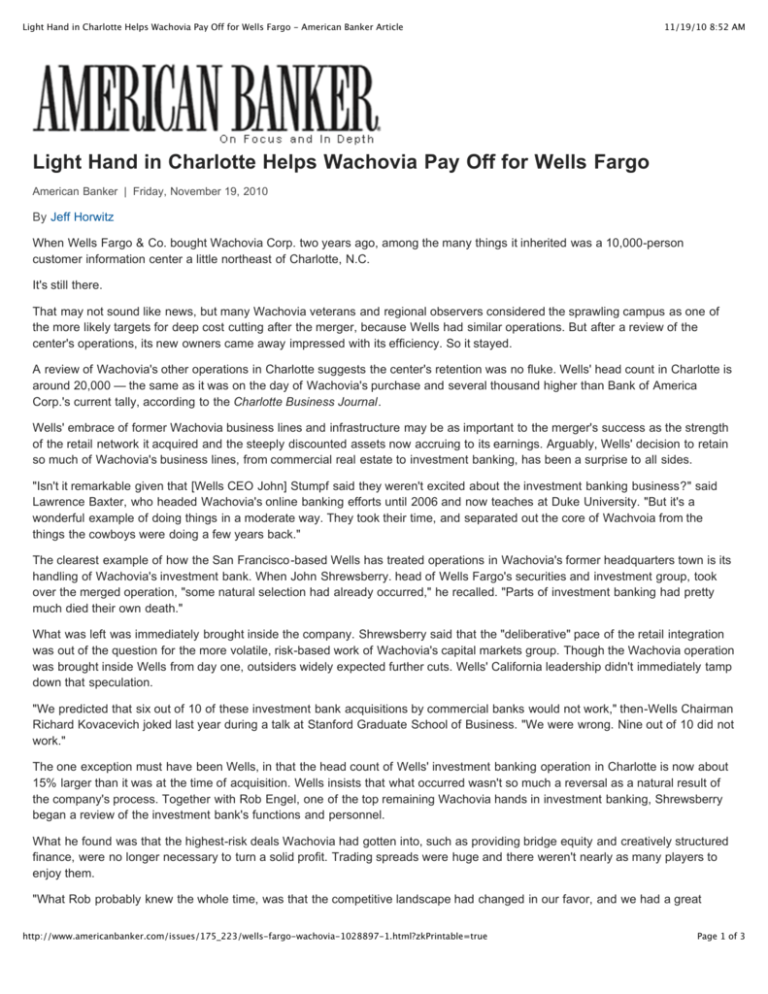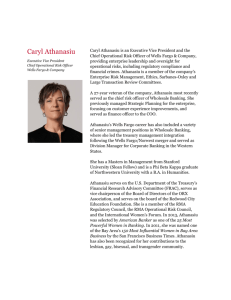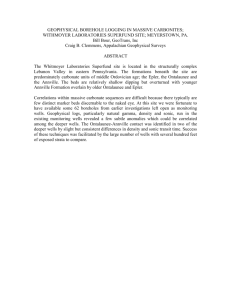
Light Hand in Charlotte Helps Wachovia Pay Off for Wells Fargo - American Banker Article
11/19/10 8:52 AM
Light Hand in Charlotte Helps Wachovia Pay Off for Wells Fargo
American Banker | Friday, November 19, 2010
By Jeff Horwitz
When Wells Fargo & Co. bought Wachovia Corp. two years ago, among the many things it inherited was a 10,000-person
customer information center a little northeast of Charlotte, N.C.
It's still there.
That may not sound like news, but many Wachovia veterans and regional observers considered the sprawling campus as one of
the more likely targets for deep cost cutting after the merger, because Wells had similar operations. But after a review of the
center's operations, its new owners came away impressed with its efficiency. So it stayed.
A review of Wachovia's other operations in Charlotte suggests the center's retention was no fluke. Wells' head count in Charlotte is
around 20,000 — the same as it was on the day of Wachovia's purchase and several thousand higher than Bank of America
Corp.'s current tally, according to the Charlotte Business Journal.
Wells' embrace of former Wachovia business lines and infrastructure may be as important to the merger's success as the strength
of the retail network it acquired and the steeply discounted assets now accruing to its earnings. Arguably, Wells' decision to retain
so much of Wachovia's business lines, from commercial real estate to investment banking, has been a surprise to all sides.
"Isn't it remarkable given that [Wells CEO John] Stumpf said they weren't excited about the investment banking business?" said
Lawrence Baxter, who headed Wachovia's online banking efforts until 2006 and now teaches at Duke University. "But it's a
wonderful example of doing things in a moderate way. They took their time, and separated out the core of Wachvoia from the
things the cowboys were doing a few years back."
The clearest example of how the San Francisco-based Wells has treated operations in Wachovia's former headquarters town is its
handling of Wachovia's investment bank. When John Shrewsberry. head of Wells Fargo's securities and investment group, took
over the merged operation, "some natural selection had already occurred," he recalled. "Parts of investment banking had pretty
much died their own death."
What was left was immediately brought inside the company. Shrewsberry said that the "deliberative" pace of the retail integration
was out of the question for the more volatile, risk-based work of Wachovia's capital markets group. Though the Wachovia operation
was brought inside Wells from day one, outsiders widely expected further cuts. Wells' California leadership didn't immediately tamp
down that speculation.
"We predicted that six out of 10 of these investment bank acquisitions by commercial banks would not work," then-Wells Chairman
Richard Kovacevich joked last year during a talk at Stanford Graduate School of Business. "We were wrong. Nine out of 10 did not
work."
The one exception must have been Wells, in that the head count of Wells' investment banking operation in Charlotte is now about
15% larger than it was at the time of acquisition. Wells insists that what occurred wasn't so much a reversal as a natural result of
the company's process. Together with Rob Engel, one of the top remaining Wachovia hands in investment banking, Shrewsberry
began a review of the investment bank's functions and personnel.
What he found was that the highest-risk deals Wachovia had gotten into, such as providing bridge equity and creatively structured
finance, were no longer necessary to turn a solid profit. Trading spreads were huge and there weren't nearly as many players to
enjoy them.
"What Rob probably knew the whole time, was that the competitive landscape had changed in our favor, and we had a great
http://www.americanbanker.com/issues/175_223/wells-fargo-wachovia-1028897-1.html?zkPrintable=true
Page 1 of 3
Light Hand in Charlotte Helps Wachovia Pay Off for Wells Fargo - American Banker Article
11/19/10 8:52 AM
trained, motivated set of people," he said. "What you were paid for the risk you take had dramatically shifted in the favor of
banking institutions."
A little less than two years later, those spreads have narrowed but remain generous. Engel says that Wachovia kept a surprising
amount of its precrisis customers, in part because Wells is investing in the business. Having long evangelized the benefits of "cross
sell" in retail, Wells found that the concept worked out just as well for corporate clients in what Shrewsberry calls the "Fortune
2000" range. Wells' operation, organized primarily around industry groups, still offers the straight corporate credit that it used to,
only now paired with investment banking and capital markets advice.
"These happen to be very high-value products," Shrewsberry said. "And the enhanced capabilities improve the risk/reward — we're
getting paid more for the same credit we might have given anyway."
This is an approach that Wells' culture can embrace, and the company has done its best to provide the wholesale bank with as
much autonomy as possible outside the strictures of risk management.
"I know nothing about investment banking," said Pat Callahan, a longtime Wells executive who returned from retirement to oversee
the merger. "But if they're going to issue debt and we're going to provide support for that. … From that point of view, we love the
investment banking business."
Wells does not break out its investment banking results from its wholesale banking group. But it earned $4.1 billion from its
wholesale banking operations in the first nine months of the year, up from $2.8 billion in that period in 2009. According to recent
comments by Chief Financial Officer Howard Atkins, 45% of the increase in investment banking revenue has come straight from a
higher volume of business from Wells' existing corporate banking clients.
For a company that had initially questioned whether it wanted to pursue investment banking, this was a significant turnaround.
"They sat with the business for a while, and didn't make any quick decisions," said Joe Morford, an analyst covering Wells for RBC
Capital Markets. "I think they came to appreciate that if they took out some of the more volatile market trading businesses, there
are a lot of products and capabilities that can enhance the way they serve their commercial bank customers."
Initially Wells surprised just by leaving existing Wachovia infrastructure in place. Two years after the merger, however, Wells is
expanding many of the capabilities it inherited, most particularly in commercial and residential mortgage-backed securities. Given
the huge volumes of commercial and residential originations that Wells produces, it only made sense to begin packaging assets inhouse, Shrewsberry said. While WFC Securities will handle only a fraction of the company's overall production, the company is
building toward gathering more than its fair share, Shrewsberry said.
There is further expansion to come. Shrewsberry and Engel say the company is especially focused on the capital needs of the
banking sector. "We will be spending more time figuring out what our full-capability value proposition is to regional banks,"
Shrewsberry said, suggesting Wells could leverage its familiarity with the sector to draw in capital raising, restructuring and assetdisposition work. (It recently assisted HSBC Holdings PLC with a $3.8 billion capital raise.)
At an investor conference this month, Atkins boasted about a couple of deals that summed up the investment business. One was a
series of mandates from Inergy, a longtime commercial client that made a sizable acquisition in September. Wells advised on the
deal, offered bridge financing and helped manage the issuance of new debt. The other was Wells' role in underwriting a $1.3
billion stock issuance by Goldman Sachs Group Inc. Wells believes it is well positioned for further such mandates, Atkins said.
"A big advantage we have is on the distribution side of the business, because of the retail securities brokerage operation we
have," he said. "There's a lot of good business here, and we're only taking as much risk as we need to take to service the client."
But a "let Charlotte be" attitude has extended well past product lines that Wells did not have. A good illustration of the bank's
relatively light touch is the continued prominence of Wachovia's customer information center, whose employees handle customer
data and phone calls.
Massive cutbacks never came, and Callahan says she does not expect them to. "If you slash like that, you're losing a ton of
institutional knowledge, and it can put you at risk. With communications, you need a network remotely."
Ironically, Wells may be more inclined to leave some crucial banking functions in Charlotte than Wachovia was. In the years shortly
before the merger, Wachovia's New York operations had grown in prominence, with key functions shifting up north. "The natural
http://www.americanbanker.com/issues/175_223/wells-fargo-wachovia-1028897-1.html?zkPrintable=true
Page 2 of 3
Light Hand in Charlotte Helps Wachovia Pay Off for Wells Fargo - American Banker Article
11/19/10 8:52 AM
inclination at Wachovia was to move everyone to New York, which seemed to me to be insane," Baxter recalled.
While Wells has maintained Wachovia's presence in New York, it wasn't about to make it more central. After initially looking into
bringing key members of Wachovia's team out west, Wells decided to keep most in Charlotte.
"Wells Fargo doesn't really care so much where you live — at the time of the [1998 Wells-Norwest] merger, this company
converted to a virtually run company," Callahan said. "And we got over it."
© 2010 American Banker and SourceMedia, Inc. All Rights Reserved.
SourceMedia is an Investcorp company. Use, duplication, or sale of this service, or data
contained herein, except as described in the Subscription Agreement, is strictly prohibited.
For information regarding Reprint Services please visit:
http://www.americanbanker.com/aboutus/reprint-services-rates.html
http://www.americanbanker.com/issues/175_223/wells-fargo-wachovia-1028897-1.html?zkPrintable=true
Page 3 of 3










